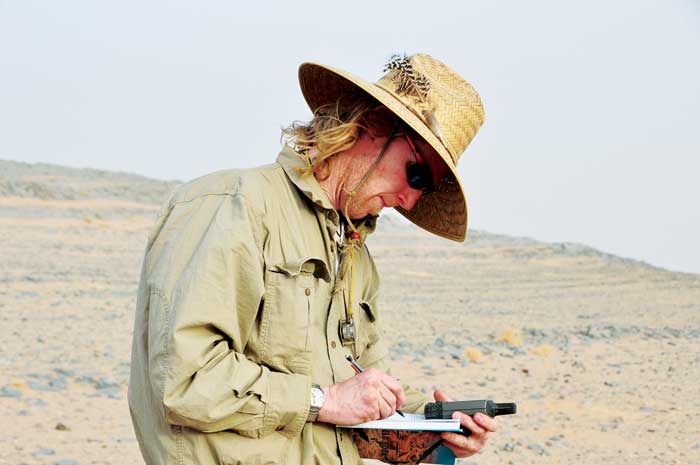
Whitey Hagadorn in the field in Saudi Arabia, recording the characteristics of 600-million-year-old rock strata.
Science is all around us. It impacts us every day. So does scientific thinking—a process where we separate fact from fiction, where we filter data from common knowledge, and where we address issues in an evaluative framework that is free from preconceptions. This approach empowers us to make informed decisions based on “the facts.”
But doing so isn’t easy. Thinking like a scientist, and using data to decipher complex problems, to evaluate “sides” of an issue, or to explore future investments requires us to set aside what we believe in order to consider and filter all the available evidence. Scientific thinking also requires us to dig deep to the roots of issues and make sure we’re comparing apples to apples whenever possible. At the crux of this process is separating our observations from our interpretations—and never letting our “hunch” color our reading of, or selection of, the evidence.
Sometimes boiling things down to the facts is the most straightforward part of a problem, but is only the beginning of a larger, thornier process that spans politics, business, religion and societal concerns. For example, scientists all agree that human-induced global warming is occurring, but knowing this does not make clear how to best slow or halt these changes, especially given our profoundly diverse individual needs and national goals.
In this column, we’ll use the scientific process to explore issues that matter to you—whether they are science-related or not. We’ll mine complex data to seek answers, but not get mired in jargon and terminology. We’ll have fun and poke fun, while exploring the underbelly of hot-button issues. I’ll try to write in a way that is understandable to non-scientists, in hopes this will help you communicate with your kids and colleagues about approaching things scientifically. As we embark on this journey, I’d be honored if this column becomes your monthly pit stop—for learning, for questioning common knowledge, and for becoming better-informed citizens of the planet.
The focus of this column will be broad. Topics might include your health, the environment, technology, science, or anything in between. One month we might debunk the health hazards of using marijuana whereas in another we’ll identify which sports are the most risky for our kids, and at what age(s) and why. Sometimes we’ll explore environmental issues, like whether we should worry that our houses sit atop the largest toxic waste plume in the Rockies…or if fracking is the DDT of our time, or just a new siren song for tree-hugging blowhards. Sometimes we’ll get economic, evaluating if a proposed bus line near your house is a noisy recipe for decreased home equity, or if it’s a boon to your bottom line. At other times we’ll report on new discoveries, like the recent meteor shower in Russia, the new fossils in Sand Creek, or reports that sunscreen is dangerous for adolescent girls.
For these journeys, I’ll be your host—a scientist and parent with admittedly broad interests and too much curiosity for my own good. Trained as a geologist, I’ve spent the last 20 years studying rocks and environments across the globe. Whether working in the lab, poring over a spreadsheet, or vstudying an outcrop in the field, I’m captivated by the thrill of discovery. What stokes my fire is new knowledge, new puzzles, and the occasional beast from deep time.
A few years ago, by luck and good fortune, I landed in Colorado with a plum new job in City Park—not to mention a newfound addiction to lip balm and hand lotion. Thus Colorado is a new experience for me, and I’m writing this column as a fellow Coloradan, hoping to learn more about issues that impact all of us, and that influence our next generation. If there’s a topic that you’d like me to address here, please let me know—we’ll try to get straight to the facts.
James “Whitey” Hagadorn, PhD, is a scientist at the Denver Museum of Nature and Science. Suggestions and comments welcome at jwhagadorn@dmns.org.



0 Comments